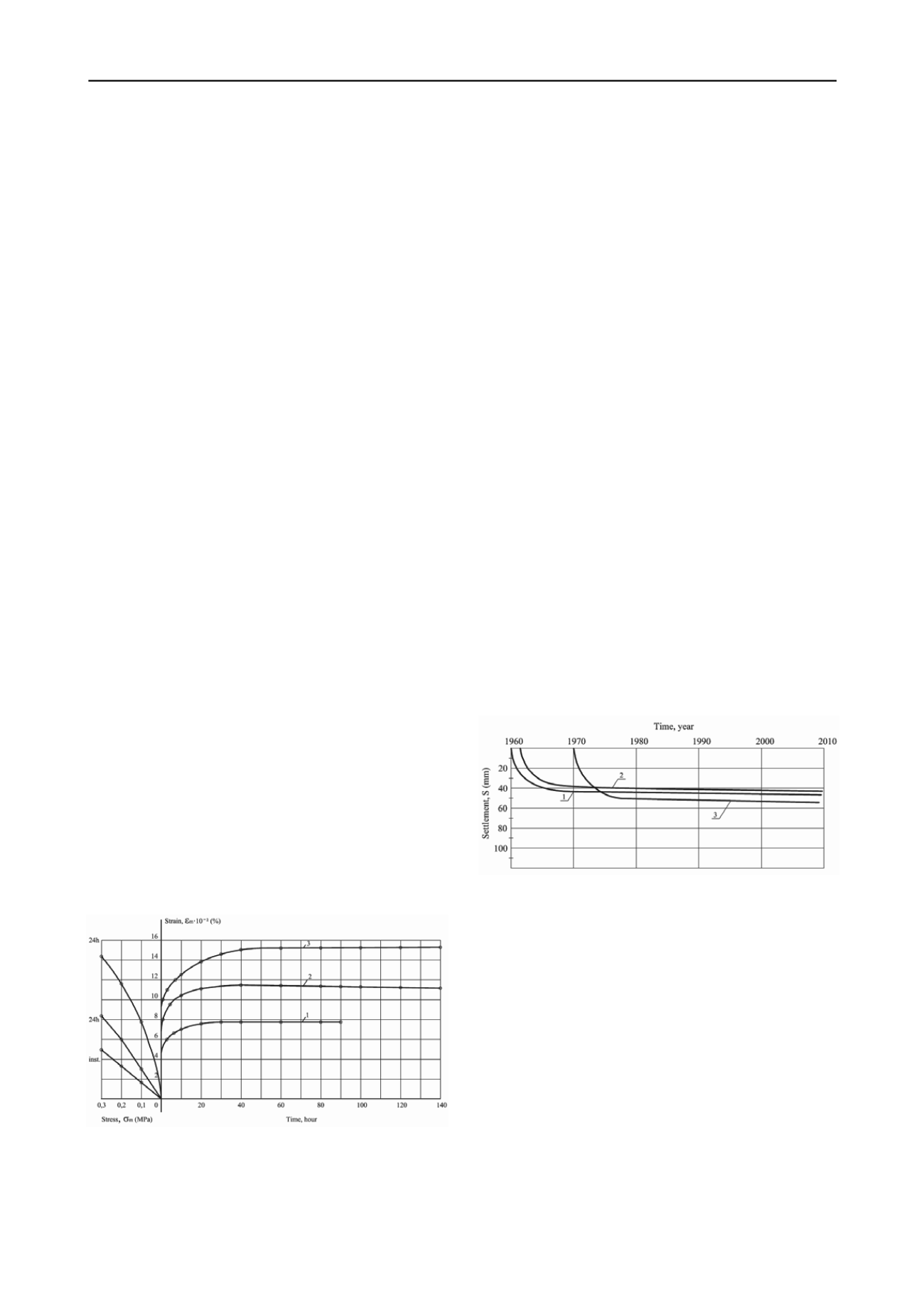
288
Proceedings of the 18
th
International Conference on Soil Mechanics and Geotechnical Engineering, Paris 2013
Proceedings of the 18
th
International Conference on Soil Mechanics and Geotechnical Engineering, Paris 2013
horizontal grids with spacing of 200 mm in both directions in
the lower zone of the foundation. In the upper zone there is the
grid reinforcement with spacing of 400 mm. The depth of the
foundation is 4.0 m. The bearing pressure is 300 t/m
2
.
The foundations of the charcoal battery structures consist of
box sections with the plan dimensions of 15.0 x 80.0 m. The
depth of the foundation is 3.5 m. Each foundation has 4 exhaust
ducts and 1 vent groove. The foundations were reinforced with
longitudinal and transverse bars with diameter 20 mm, class A -
II. The bearing pressure is 18.0 t/m
2
.
The foundations of the 250 meters tall chimney structures
are made of monolithic reinforced concrete. The foundation
base is round with the diameter of 40.0 m and height of 4.0 m.
The design load at the base of the chimney is approximately
21.1 t/m
2
. The adopted concrete grade for all types of
foundations was M300 on the Portland cement. Based on the
site-investigation to a depth 30.0 m, the groundwater was not
revealed.
4 LABORATORY STUDIES OF CREEP BEHAVIOR
The volumetric creep behavior of clayey soils under hydrostatic
compression was investigated on the triaxial testing devices by
applying a constant load (Tatsuoka F., Shibuya S. and Kuwano
R. 2001).
The results of the studies show that the structural strength of
the samples of clay with natural moisture and density content
ranged from 25 ÷ 100 kPa; it was established experimentally
that the consolidation process of the intact samples taken at
different depths is significantly different with respect to time
and deformation modes. The intensity of consolidation for the
investigated soils under axial stresses of 25 ÷ 100 kPa is
practically unchanged. It was mainly determined by the
destruction process of the soil structure and the development of
creep in the soil skeleton over time at the axial stresses of 100 ÷
400 kPa. The existence of transient creep in shear has been
established experimentally. The shear creep deformations at the
given loads in the saturated state exhibited gradually decreasing
character (Zhakulin A.S. and Zhakulina A.A., Kropachev P.A.
2011, Nakai T., Shahin H., Kyokawa H., Miyahara Y. 2011.).
The following plots were obtained based on the
investigation:
– volumetric strains -time;
-relationship between the hydrostatic pressure and
volumetric strain;
– pore pressure-time.
Figure 1 shows the test data volume creep of clay. The
values of the hydrostatic pressure in the experiments were:
т
=
0.10; 0.20; 0.3 МPа.
Figure 1. Volumetric creep curves of clay. 1 – at
m
=0.1 МPа, 2 – at
m
=0.2 МPа, 3 – at
m
=0.3 МPа
The results revealed that with the increasing
m
, the
stabilization time of the volumetric strain is increasing. It
should be noted that the experiments on the intact samples with
natural moisture-density content showed that the volumetric
strains were gradually decreasing for 1.5-2.0 days. When
т
was changed from 0.1 to 0.3 MPa the volumetric strains
increased by 2.1 times. During the study of the volumetric
deformations of the saturated clay samples, an increase in the
time of stabilization with an increase in the hydrostatic
pressures was observed. Therefore, at
т
=
0.1 МPа the full
stabilization of volumetric creep deformations was achieved in
3-3.5 days, while at
т
= 0.3 МPа this time increased to 5-7
days.
The values of volume strains when tested on clay samples
for volumetric creep upon application of step-increasing loads
were slightly less than upon the step application. This indicates
that the step-increasing loading contributes to hardening of
soil at each step and causes less strain than applying the same
magnitude of a constant load.
However, the deviation was not more than 12.5%, which
allows the use of the Boltzmann deformation imposition law.
The laboratory results indicate that the soils exhibit gradually
decreasing creep behavior (Vyalov S.S. 1978, Bulychov N.S.
1989).
5 SETTLEMENTS OBSERVATION RESULTS AND
THEIR ANALYSIS
The elastic deformations of the magnitude of 12 mm were
recorded during the dismantling of the blast furnace in 1985.
The settlements stabilized in 2 months after the erection of the
blast furnace. A similar pattern was observed in the
reconstruction of the most blast furnaces.
The graph of the settlements of the blast furnace in time is
shown in Figure 2. Upon the complete replacement of the oven
batteries in 1986, the elastic deformations of 9 mm were
observed which represented the one fifth of the total settlement.
The graphs of settlements over time for charcoal oven batteries
are shown in Figure 3.
Figure 2. Settlements of blast furnaces over time. 1 - furnace #1, 2 -
furnace #2, 3 - furnace #3.
The foundation base of the chimney is underlying by red-
brown clay with semi-solid consistency. The stabilization of
foundation settlement occurred in 5 years after the construction
of the reinforced concrete stem.
The graphs of settlements of concrete chimneys in time are
shown in Figure 4. It was found that the deformations of the
foundations of blast furnaces and oven batteries were occurring
for 2-3 years after their commissioning. The foundation
settlements of the chimney structures faded immediately after
the completion of construction work.
The comparison of the theoretical solutions and the long-
term field settlement observations for 50 years provides a great
deal of scientific and practical interest. In order to compare the
design values with the actual and maximum allowable values of
settlements (by building codes), the settlements of the
foundations of the blast furnaces, charcoal oven batteries and
250 meters tall chimneys were re-analyzed.


